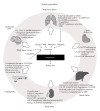Role of complement in multiorgan failure
- PMID: 23320021
- PMCID: PMC3539671
- DOI: 10.1155/2012/962927
Role of complement in multiorgan failure
Abstract
Multiorgan failure (MOF) represents the leading cause of death in patients with sepsis and systemic inflammatory response syndrome (SIRS) following severe trauma. The underlying immune response is highly complex and involves activation of the complement system as a crucial entity of innate immunity. Uncontrolled activation of the complement system during sepsis and SIRS with in excessive generation of complement activation products contributes to an ensuing dysfunction of various organ systems. In the present review, mechanisms of the inflammatory response in the development of MOF in sepsis and SIRS with particular focus on the complement system are discussed.
Figures

References
-
- Baue AE. Multiple, progressive, or sequential systems failure. A syndrome of the 1970s. Archives of Surgery. 1975;110(7):779–781. - PubMed
-
- Martin GS, Mannino DM, Eaton S, Moss M. The epidemiology of sepsis in the United States from 1979 through 2000. The New England Journal of Medicine. 2003;348(16):1546–1554. - PubMed
-
- Demetriades D, Murray J, Charalambides K, et al. Trauma fatalities: time and location of hospital deaths. Journal of the American College of Surgeons. 2004;198(1):20–26. - PubMed
Publication types
MeSH terms
Substances
LinkOut - more resources
Full Text Sources
Other Literature Sources

